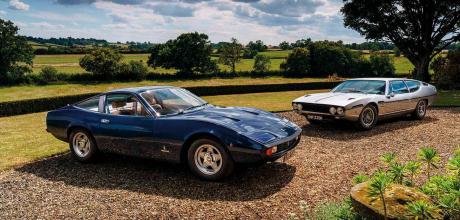1972 Ferrari 365 GTC/4 vs. 1970 Lamborghini Espada
Why underrated Espada and 365 GTC/4 offer all the glorious V12 thrills of their exotic brethren for a fraction of the price. Lamborghini’s Espada and Ferrari’s 365 GTC/4 have long existed in the shadow of more exalted siblings. Richard Heseltine says it’s time they received greater recognition.
Photography Dean Smith
THE MISFITS LAMBORGHINI ESPADA AND FERRARI 365 GTC/4
Why collectors are now discovering the charms of these V12-powered former misfits
Paradise is a word used promiscuously by travel magazines, but this may well be it. There’s an azure sky, tufty clouds, and fields of wild flowers stretch into the distance to complete the masterpiece. More importantly, though, the scenic vista is dissected by smooth asphalt, a series of long straights connected via flowing corners. Perfect.
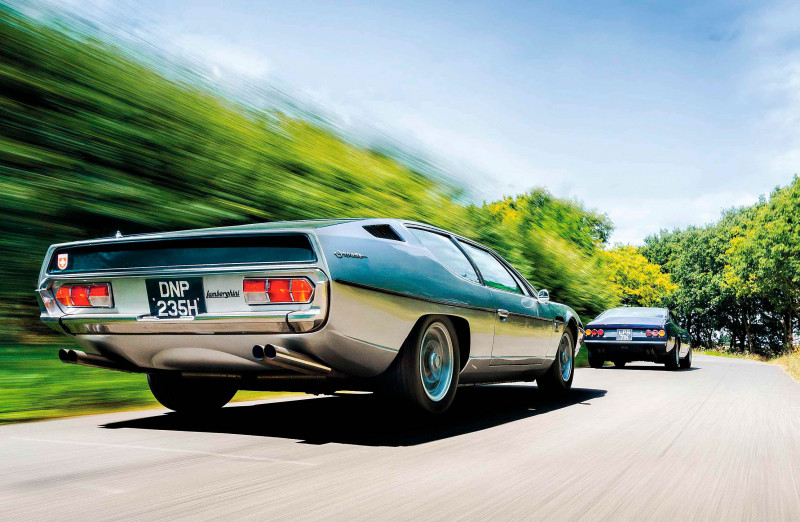
Then our featured cars hove into view, though their V12 powerhouses have already trumpeted their arrival. Not that they’re anti-socially loud; no, here we have the muted bark of a chain-driven Italian V12 of the old school, tickled along rather than redlined, overlaid with the voice of another. It’s the sort of noise that echoes a vanished time, of beautiful people heading to beautiful locales in their beautiful Italian GT cars.
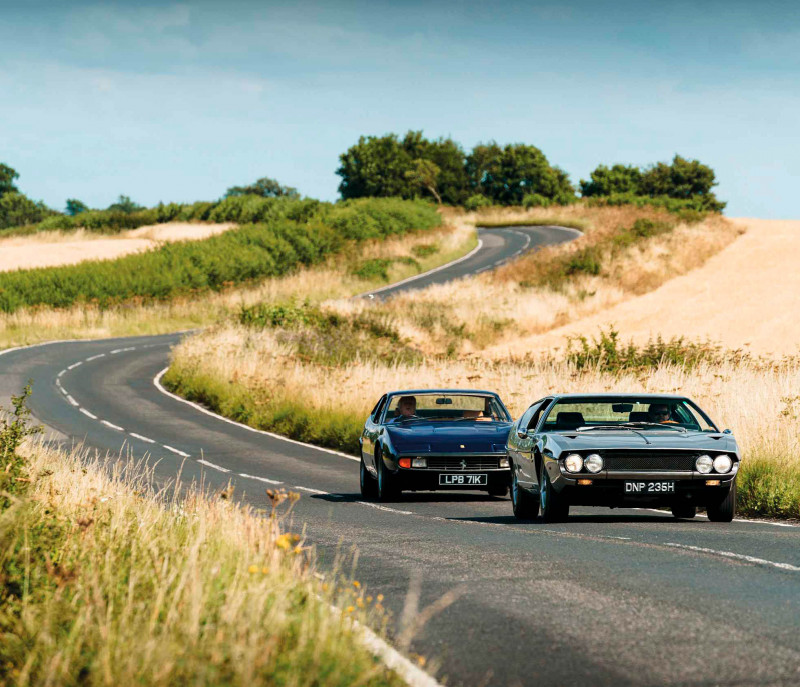
Make no mistake, the Ferrari 365 GTC/4 and the Lamborghini Espada are true Gran Turismos in the oldfashioned idiom, although it’s fair to say that this pairing isn’t the most obvious you could make. And that’s exactly the point. Other examples of each marque are better known, more valuable, less the underdog. Yet these two are undeniably exotic, they each exert their own kind of appeal, and they are comfortable enough to spend hours aboard without adopting the sort of contortions your leading yogis can only dream of. They were aimed at moneyed silverbacks, after all. It’s just that the establishment in Maranello and the arrivistes over the hill in Sant’Agata typically had their own way of doing things. Although it shared its 4.4-litre V12 with the Daytona, the GTC/4 had different cylinder heads, a lower compression ratio and sidedraught rather than downdraught Weber induction. This sacrificed top-end power, European-spec cars packing 15bhp less at 335bhp, but resulted in a lower bonnet-line. The biggest deviation from the Daytona was the placement of its five-speed ’box, mated to the engine rather than slung out back as a transaxle. The all-wishbone suspension embraced self-levelling gas/oil struts at the rear, and the car boasted ZF power steering that had been denied the Daytona. The end product emerged taller, longer and a mite wider than the Daytona, too, but then it had the edge in accommodation, although to label it a 2+2 was a stretch. Pininfarina was never big on crediting individual stylists, though the GTC/4’s outline has more recently been attributed to Filippo Sapino (Pininfarina also constructed the bodies). Introduced at the 1971 Geneva motor show, it remained in production for just two years, during which time 505 were made.
‘THE ESPADA REMAINS AN ACQUIRED TASTE, OF COURSE – BUT SO DOES THE FERRARI’
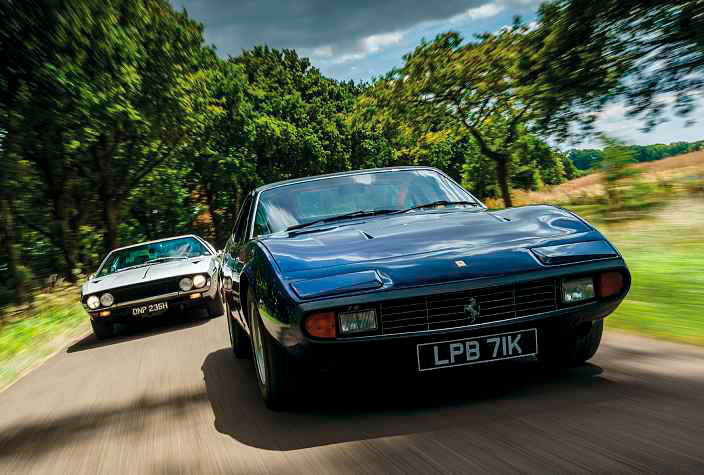
The Espada had been introduced at the same venue in 1968, two years after the seminal mid-engined Miura and a year after the radical Marzal that inspired it. It was met with muted hoopla by the automotive media, possibly because its styling had been diluted and stretched somewhat in comparison to the Marzal. Mechanically, the car borrowed heavily from the 350/400GT and the Islero (which also appeared in 1968), with power coming from the firm’s proven quad-cam, all-alloy 3929cc V12. Devised by Giotto Bizzarrini and refined by Gian Paolo Dallara, this jewel of an engine was fed by a sextet of twin-choke Weber carbs and produced an alleged 325bhp. It was mated to an in-house five-speed ’box and final-drive unit, with the option of a limited-slip diff, all housed in a punt-type chassis comprised of sheet steel pressings.
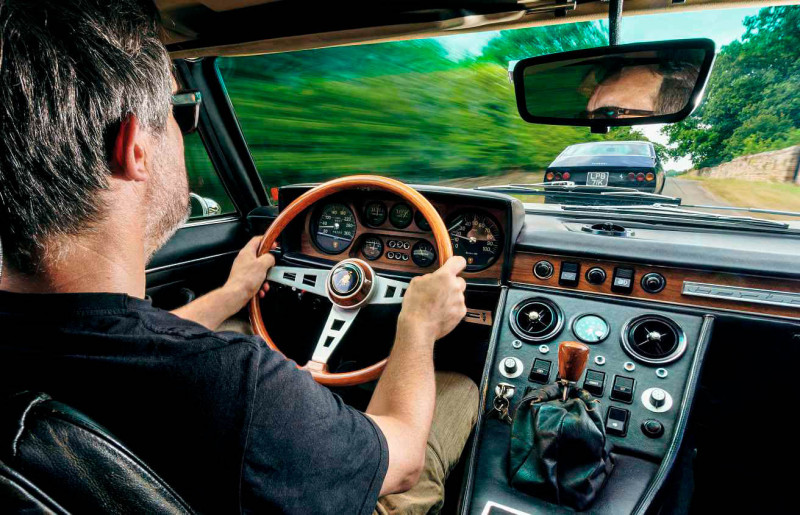
Additional tubular structures acted as mounting points for engine, transmission and suspension: unequal-length double wishbones, combined spring/damper units and anti-roll bars at both ends. Steering was via ZF worm-and- sector, and Girling disc brakes featured all-round.
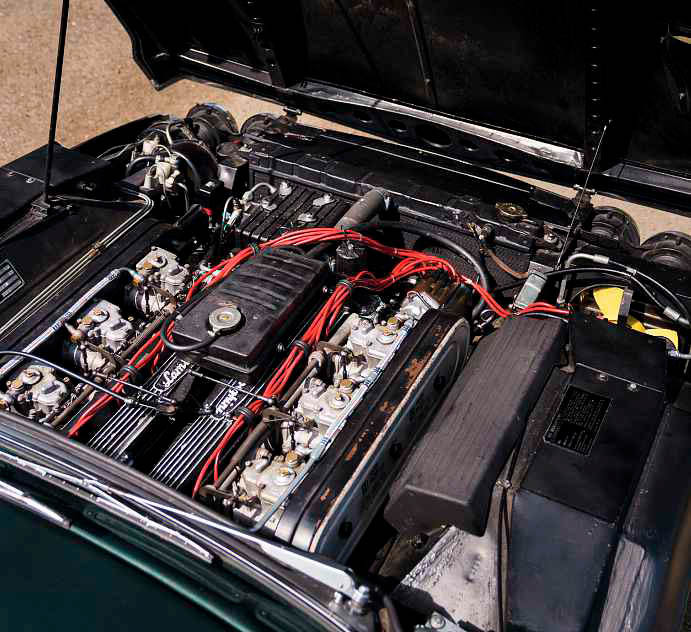
Much of the Espada’s construction was farmed out, with Marchesi of Modena fabricating the chassis. These were then transported to Bertone in Turin for the steel and aluminium bodies to be fitted, before heading to Sant’Agata for the installation of running gear and final assembly. Lamborghini continued to develop the model, introducing the Series II edition (or 400 GTE in some promo material) in 1970, complete with a lower floor to increase rear headroom, a more logical (well, ish) dash layout, and larger vented discs. Power was raised to 350bhp, but this hike was of the fanciful variety.
‘THIS PAIRING ISN’T THE MOST OBVIOUS YOU COULD MAKE. AND THAT’S EXACTLY THE POINT’
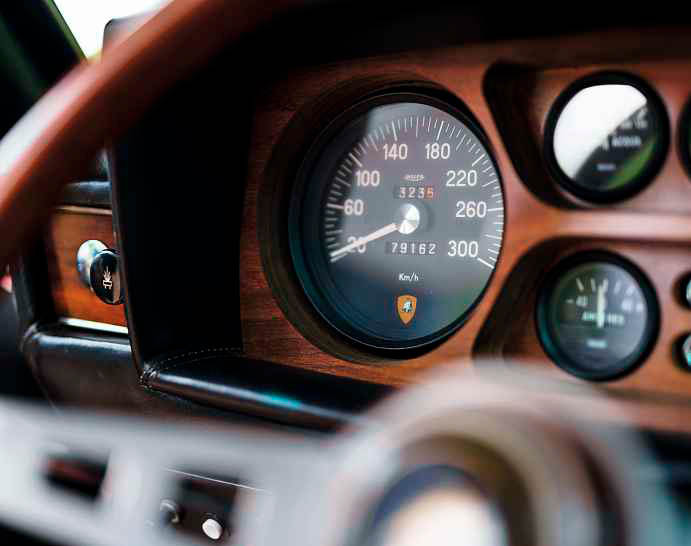
A third iteration arrived in 1973, with power-assisted steering and air-con as standard. A further dashboard revision and suspension tweaks completed the makeover; a three-speed TorqueFlite automatic transmission option came a year later. By the time production ended in 1978, 1217 cars had been made. With the exception of the rare LM002 off-roader, and one-off show cars such as the Faena, Portofino, Genesis and fabulous Estoque, this was Lamborghini’s sole ‘proper’ four-seater until the advent of the Urus SUV in 2018.
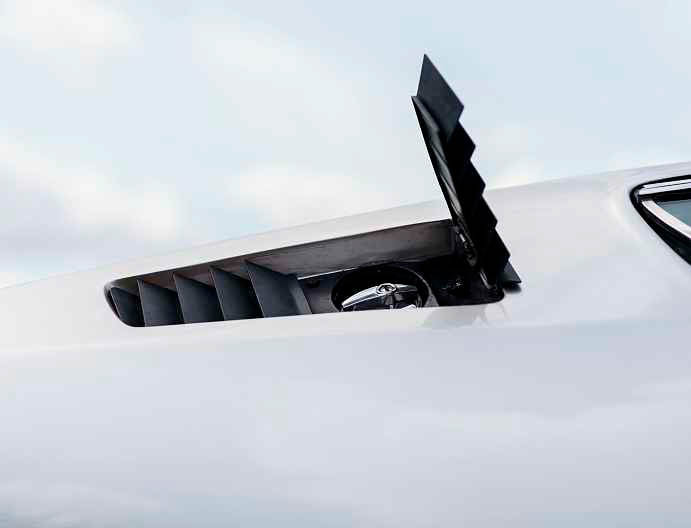
Standing just 46in high but 73.2in wide and 186in in length, the Espada’s executive-saloon proportions shouldn’t work (it’s 4in lower than the Ferrari, but 3in wider and 7in longer). Yet it’s hard not to be swayed. The rear three-quarter view is especially accomplished: the ‘floating’ glass tail panel subsequently reappeared on another of Marcello Gandini’s masterworks, the Maserati Khamsin. Everywhere you look there are exquisite details, such as the stylised Espada scripts on the rearmost flanks, and the faux louvres in the C-pillars, which conceal the fuel-filler caps. The aluminium bonnet, with its two NACA ducts that funnel air to the cabin (sort of), is vast but is lightly creased so as not to appear completely flat.
The Espada remains an acquired taste, of course, but so does the Ferrari, even if it’s the more conventionally attractive of the two. Yet some quarters of the media continue to claim that it represented a damp squib after the Daytona. That’s a mite unfair given that the Daytona was – and remains – a landmark design in marque lore. As an aside, the car was nicknamed Il Gobbone in its homeland. That translates as ‘hunchback’. Up close it’s nothing of the sort; more a poetic blend of soft curves. Inside, the large windows and spindly pillars afford a panoramic view, and the round instruments in square blocks add a modernist flourish. The ski-slope-like centre panel is home to the switchgear and the gaitered gearlever.
You sit low, raked back, but the driving position is comfortable and the pedals aren’t quite as skewed as they are in the Lamborghini. It’s a nice office, and it’s hard not to fall for the tartan seat inserts, but even with air-conditioning it can get a wee bit toasty in here.
The Espada may have been aimed at the more mature customer, but few concessions were made to ease of ingress, thanks to the low roofline and the severe rake of the steering wheel. The dash on this Series II car is handsome, the 190mph speedo and 10,000rpm rev-counter being the main points of focus. You are forced to adopt a slightly legs-splayed driving stance, although the steering column is adjustable (with the aid of spanners). The gauges’ lower calibrations are obscured by the wheel-rim, but north of 8000rpm you would probably be too busy concentrating to care.
The seats are ultra-comfy and there is genuine space for rear-ferried passengers. Make no mistake, this car will seat four adults. Then you fire it up and the other side of the Espada’s character emerges. At idle the V12 isn’t superloud, which is in keeping with the gentleman’s express ideal, and at low speeds the Lamborghini feels disappointingly uncoordinated. However, once above 20mph or so, it undergoes a metamorphosis: the steering becomes light and precise and the gearchange shorter in its movement across the gate, as well as easier to guide. What is telling is that you’re not intimidated by the car’s size. Time was when the Espada appeared ludicrously wide, yet these days it’s narrower than many hatchbacks. You can position it with accuracy, and on typically rutted B-roads it doesn’t tramline. Contrary to what preconceptions might have you believe, it feels taut, without any banging or crashing through the structure.
This is a car that metaphorically shrinks around you; it isn’t a point-and-squirt weapon, but the Espada is infinitely more agile than it is widely given credit for. On being afforded sufficient space to stretch its legs, the V12’s strident bellow is enthralling. Seriously, it’s worth having an Espada just to listen to it running the sonic spectrum from playful bark to feral howl as you pile on the revs. The brakes, too, are superb considering their vintage, with plenty of pedal feel. While there are a few annoyances, not least random switchgear that is baffling at a glance, it’s hard not to emerge smitten.
The same is true of the Ferrari but for different reasons. The owner of this example, one of 31 sold in the UK with right-hand drive, suggests that it drives much like a modern car. It does, too, albeit with one or two caveats. Like the Espada, turning the ignition key doesn’t result in surround-sound fanfare. It’s far too dignified for that, although a quick blip is rewarded with an eye-widening roar. The long-travel throttle pedal is on the stiff side, but then the car is packing six twin-choke Webers. Ease it into gear, let up the clutch and the GTC/4 is utterly docile.
The hydraulic steering assistance helps massively at low speeds, while acceleration is keen without trying particularly hard. It isn’t slow by any definition but there’s no sense of theatre either; no speedboat-like elevated nose and tail-squat antics. Speed merely builds, overlaid with a rich, blue-blooded and full-bodied soundtrack. When cruising, it is audible but never intrusive. The V12 powerhouse is wonderfully flexible, the gearchange precise if not quite in the same league as the Espada’s. There is no dogleg operation as in the Daytona, with only fifth being out on a limb.
Such is the torque spread (317lb ft of it), you don’t need to race up and down the ratios. Even in top, it pulls cleanly and without hesitation. Given its Maranello origins and the era from which it dates, the GTC/4 is easy to drive: unthreatening in a manner that many comparable exotics are not. Driving one isn’t a battle of wills, nor is it a white-knuckle thrill ride. The car turns-in crisply, free of lurch, and its manners are predictable. The steering doesn’t demand constant corrections. Having had prior experience of the model at three-figures, I can tell you that high-speed stability is commendable.
The brakes – vented discs – work well, with decent pedal feel. The only area where the GTC/4 shows its age is in its ride quality – in a good way. Compared with most latter-day exotica, where your spine acts as a shock absorber, it’s reasonably pliant. You feel bumps, of course, and you certainly hear them, but overall the Ferrari is lovely. It’s a car you can imagine driving long distances, which is what a GT car is about after all.
As to whether it’s a better car than the Espada, that is an impossible question to answer. The GTC/4 is a fine allrounder and every inch a classic GT. It is also that rarest of things: an underrated Ferrari. It’s hard not to abandon yourself to the Espada, though, as much for its grounded spaceship looks as the way it makes you smile.
The Ferrari is a car that appeals as much to the head as the heart, but the Lamborghini pulls off the rare feat of making no sense at all yet all the sense in the world. For better or worse, the Espada is unlike any other car. And that’s why we love it.
THANKS TO Jonny Ambrose, Neil Lefley and the Ferrari Owners’ Club of Great Britain (ferrariownersclub.co.uk). The Lamborghini is for sale: email jonnyambrose74@gmail.com.
Left, from top Ferrari’s boxy instrument housings look more modern than 1971; rear seats are less commodious than the Espada’s; another Modenese masterpiece of a V12.
TECHNICAL DATA 1972 Ferrari 365 GTC/4
- Engine 4390cc V12, DOHC per bank, six Weber carburettors
- Max Power 335bhp @ 7500rpm
- Max Torque 312lb ft @ 4000 rpm
- Transmission Five-speed manual, rear wheel drive
- Steering Worm and roller, power-assisted
- Suspension Front and rear: unequal-length wishbones, coil springs, telescopic dampers. Front anti-roll bar; rear self-levelling
- Brakes Discs
- Weight 1450kg
- Top speed 155mph (claimed)
- 0-60mph 7.3sec
Above and below; and facing page, bottom Espada features a broad flightdeck of a dashboard; Ferrari was nicknamed ‘hunchback’ yet is by far the more traditional of the two; Lamborghini V12 was Bizzarrini’s masterpiece.
TECHNICAL DATA 1970 Lamborghini Espada
- Engine 3929cc V12, DOHC per bank, six Weber carburettors
- Max Power 325bhp @ 6500rpm
- Max Torque 276lb ft @ 4500rpm
- Transmission Five-speed manual, rear wheel drive
- Steering Worm and roller
- Suspension Front and rear: double wishbones, coil springs, telescopic dampers, anti-roll bar
- Brakes Discs Weight 1759kg
- Top speed 150mph
- 0-60mph 6.5sec
Right From this angle, you can see exactly how the Espada’s unconventional proportions compare with the more classical dimensions of the the Ferrari.


